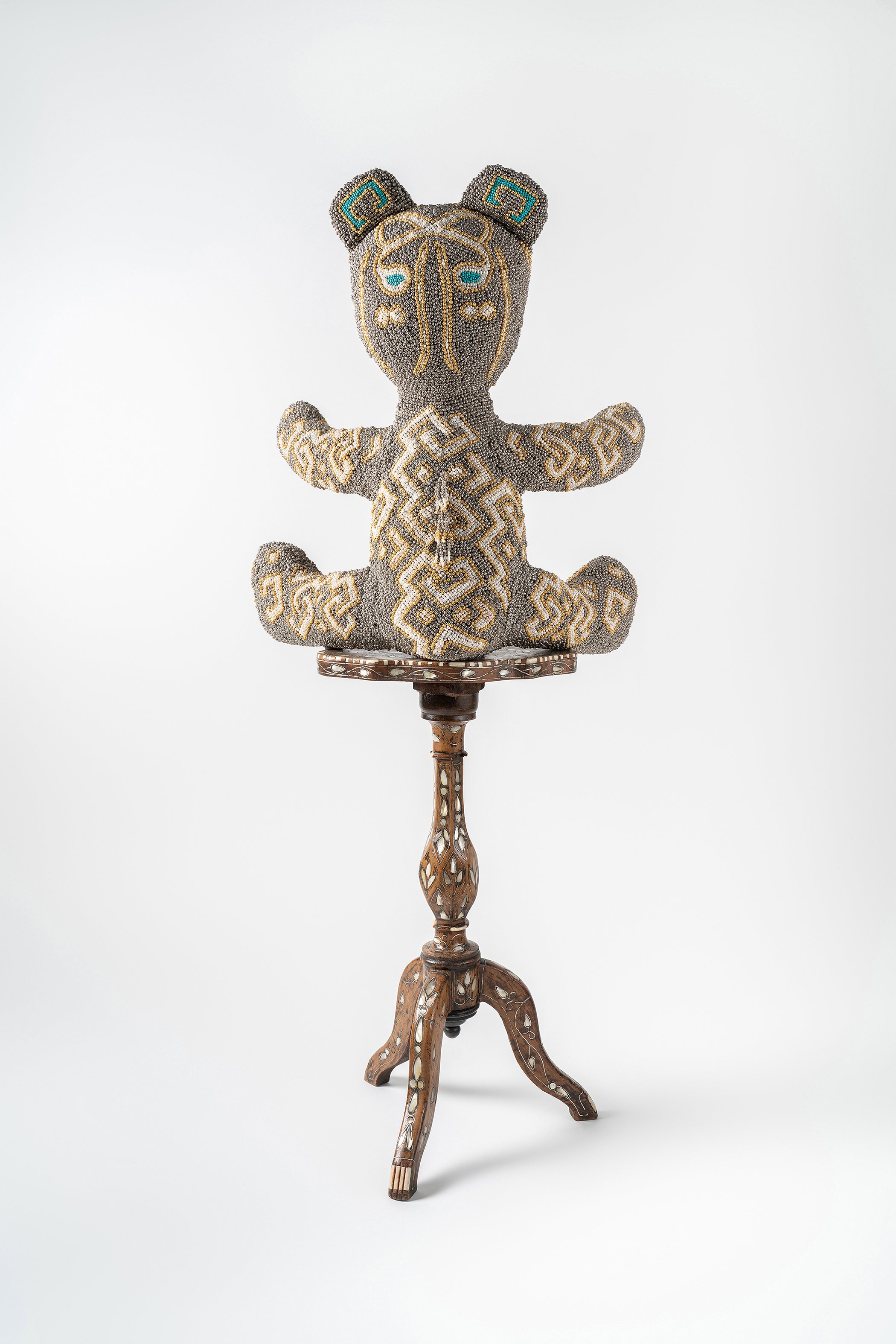Ignacio González-Lang
Papi, 2020, recycled US military trench coats, lacquer wood stand, cotton thread, acupuncture needles, wire, 70 x 64 x 5”
BIOGRAPHY
Ignacio González-Lang was born in Bayamon, Puerto Rico. He received a Bachelor of Fine Arts degree from California Institute of the Arts and a Master of Arts degree from Columbia University. He’s an artist and educator based in New York City. He’s currently an Adjunct Professor at the School of Visual Arts in New York. He has exhibited his work nationally and internationally in museums including MoMA PS1, New York, Bronx Museum, New York, El Museo del Barrio, New York, Contemporary Art Museum St. Louis, MO, Abroms/Engel Institute for the Visual Art, Birmingham, Alabama, Jewish Museum & Tolerance Center, Moscow, Jewish Museum, Vienna, Frost Art Museum, Miami, OK Centrum Fur Gegemwartskunst, Linz, Austria, Institute for Contemporary Art, London, Contemporary Art Center, Vilnius, RISD Museum, Providence, Art in General, New York, International Center of Photography, New York, and Fundacion Joan Miro, Barcelona, Spain. His work has been reviewed in publications such as the New York Times, New Yorker, Artforum, Art Review, Los Angeles Times, Art Papers, Artnet, Hyperallergic and CNN. My awards and residencies include Pollock-Krasner Foundation International Studio and Curatorial Program Fellowship, NYFA Fellowship in Sculpture, Cintas Grant Finalist, Art Matters Grant, The Hayward Award and, Museo de Arte de Ponce; Acquisition Prize.
STATEMENT
Papi is a work in the series, Familia, that repurposes military fatigues as a response to our culture of endless wars. My interest in using fatigues began when my father, a Cuban immigrant and Vietnam combat veteran, gave me his military trench-coats. Vietnam is the first war where more US combatants were lost to suicide after the war than those killed during the combat. In fact, in the past 20 years, more than 30,000 active military and veterans of post 9/11 wars have committed suicide, a number fours times as many as those killed in action.These works were inspired by a subculture among veterans where uniforms are transformed into artworks as therapy for PTSD. This series consists of five works modeled after my family unit; mother, father, brother, sister and baby. The military fatigues are transformed into various new objects and embellished using thread, embroidery and beading in order to make a human connection between war and its transformative effects on the individual and the community.
Brother, 2018, Recycled US military uniform, digital microscope, motherboard, cotton thread, weatherproof protective hard case, 22 x 2 x 17 inches.
Brother incorporates a weatherproof hard-case for electronics commonly used in the military. A traditional Afghan (Hazara) pattern was embroidered on the back of a military shirt.The fabric was then stretched across a cushion inserted into the briefcase. A digital microscope in the case is focused on a microchip embedded inside.
Hermana, 2014, recycled US military uniforms, US quarter coins, beads, cotton thread, mother of pearl buttons, silver thread, crochet, lace, metal bells, 40 x 37 x 6.5 inches
In Hermana the military fatigues were transformed into an Afghan (Kochi) dress embroidered with traditional patterns and US quarter coins.The garments of the nomadic Kochi were appropriated as fashion by the anti-war peace movement of the 1960s and early 1970s completing the sculpture’s cyclical historic connections.
Madre, 2019, recycled US military uniforms, coral, lapis lazuli beads, turquoise beads, mother of pearl beads, jade beads, imitation pearls, military buttons and pins, enamel pins, safety pins, cotton thread, wood, 76 x 52 x 2 inches.
Wars and military interventions release enormous amounts of carbon dioxide to the atmosphere and cause significant environmental destruction. If the US military were a country, it would rank 47th in the list of highest total emissions in the world. In addition, explosives, fire pits and other modern warfare directly harm the environment, wildlife and biodiversity. Pollution from war contaminates the water, the earth, and the air, making areas toxic and unsafe for populations to survive. Madre consists of a patchwork quilt created from military fatigues and embroidered by metals and minerals that relate to the geographic locations of US post 9/11 conflict. The imagery represents temperature extremes that are the result of climate change caused directly by war.
Bebé, 2017, recycled US military uniforms, lapis lazuli beads, turquoise beads, pearl beads, zinc beads, metal beads, gold plated beads, thread, zipper, mother of pearl and wood pedestal, 42 x 22 x13.5 inches with pedestal
The entire surface of Bebé is covered with silver-grey zinc and gold beads, pearls and lapis lazuli stones.It was inspired by the Beaded Zemi in Rome's Pigorini Museum, an example of Taino art produced before the disappearance of this culture in 16th century. Tainos were the principal inhabitants of Puerto Rico before the settlement of the region by Spanish colonists. The work represents a supernatural character with coexisting Taino, African and European features. I wanted to reimagine it using the familiar form of the teddy bear, an object that is a globally recognizable signifier of warmth, love and home.





